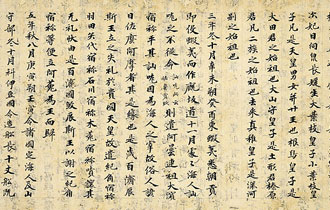Pages |
The reflection works both ways. In kabuki, at the attack of an opposing army, a hero is able to fight off large numbers of men against great odds and lop off the heads of the opponents with a single swoop of his sword, not of course literally, but by having the actors bend over and go slithering off stage. There is no pretense of making the audience think that the fight is authentic. In bunraku the dolls' heads are hinged so that the manipulators can release them at the neck and they can fall back with the swing of a sword to reveal the red paint on the severed neck in imitation of blood. On more than one occasion kabuki reflects this bunraku practice by using dolls in armed conflict to represent the enemy. The dolls are carried by kōken, assistants, who, because they are dressed in black in the manner of the bunraku manipulators, spectators are supposed to disregard. In this case the kabuki is reflecting the practice of bunraku rather than the other way around. One can see kōken from time to time helping in the actors' quick costume exchanges in kabuki. When the kabuki performance reflects the practices of nō, for example, such as in a dance performance, the kōken wear hakama, as the kōken do on the nō stage.
In these performances, the instruments of nō are featured, however, with a greater number of drums-the ōtsuzumi, kotsuzumi and taiko, and flutes, called fue. These three theatrical forms reflect each others' practices. However, one could almost say that to the extent kabuki and bunraku exaggerate and accentuate reality for the visual and aural pleasure they can provide an audience, nō in many ways, and to the same extent, removes itself from reality for its unique type of visual and aural pleasure. The nō set is always the same and does not change as it does in kabuki and bunraku. In nō the back wall shows a pine tree and on the side there are painted bamboo trees. This is always the case, whether the setting is supposed to be a temple or a beach. The props are minimal. The spider web in Tsuchigumo and the bell in Dōjōji are the most elaborate. The costumes are usually elegant rather than brilliant and gorgeous. There are exceptions, such as the dancer in Dōjōji, dressed in a robe with an abstract snake design, or the lions in Shakkyō.
The bridge, hashigakari, in nō is close to the audience, but does not pass through the auditorium, as the hanamichi does in kabuki. It passes from backstage right at an angle to the raised nō stage. The delivery of the main actors of nō is more resonant than intelligible, except to those who know the text well. In kabuki the language and voices are intelligible. There are only three or four musicians in nō, larger ensembles in kabuki. In some respects the nō today has become both a spiritual and aesthetic experience; kabuki and bunraku are entertainment. The latter two have always appealed more to the merchant and bourgeois class; the nō became the aristocratic art of the shogun and his court, which is part of the reason why kabuki and bunraku emerged. The difference is not merely one of status within society, but the level of expertise in the metaphysics of classical Japanese poetry required by audiences.
And yet these are all Japanese forms of theater sharing culturally specific aspects, such as, the language, the basic approach to costume, the facial features, legends and myth, religious assumptions, and so forth. In addition, there is the way in which these serious theaters point to themselves metatheatrically.
Pages |











